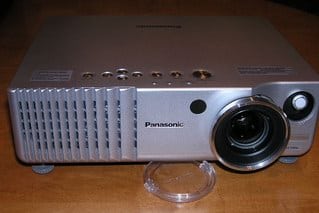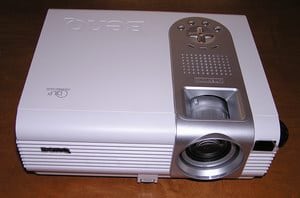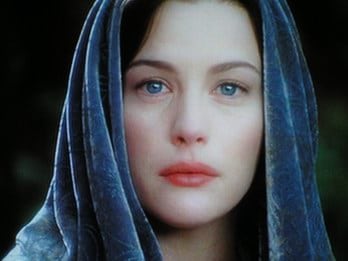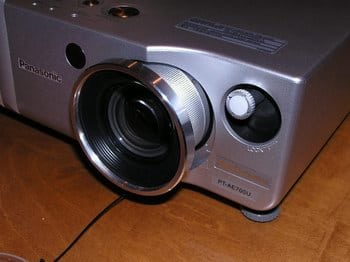For the online shopper there are choices of projectors at most price points, however many of the best and most expensive projectors (over $10,000) are available only at your local specialty home theater store, or custom installation company. Here’s how I have organized this reference guide:
Editor's note, almost one decade later. What an incredible difference looking back to 2004, in the first years of non-CRT home theater projectors. "Newbies" might find this old perspective interesting.
 Click Image to Enlarge
Click Image to Enlarge
- Under $1000 lower resolution business projectors and some dedicated home theater projectors
- $1500 price point, more home theater projectors and bright biz projectors for brighter rooms, some higher resolution, brighter business projectors that work well at home
- All in one projector/DVD player/audio system (only one model shipping)
- The hot $2000 market – higher resolution HT projectors, dominated by LCD 1280x720 projectors and 1024x576 res DLP projectors
- $3000 - $5000 Dominated by 1280x720 resolution DLP projectors
- $5000 - $10,000 More, better DLP projectors and DILA-models
- $10,000+ Projectors in this price range are typically not available online, sold through local stores or by custom installers, those under $15,000 are often comparable to under $10,000 priced models available online.
- Screens and things
- Summary
Entry Level Projectors - Starting Under $1000
It’s true that you can start at under $800 for an entry level business projector, that can double for home entertainment, however projectors specifically designed for your home theater now start right at the $1000 mark.
Two very popular and well reviewed models that have just started appearing as low as $999 are BenQ’s 5120 (image on the right), a DLP projector with extremely good color handling and excellent contrast, and Mitsubishi’s HC-3, an LCD model that is the brightest low cost HT projector around, and an excellent choice if you have more than minimum ambient light in your room. There are several other home theater projectors, also mostly the lower resolution WVGA (854x480) models, with prices up to about $1300.
 Click Image to Enlarge
Click Image to EnlargeProjectors Selling for Approximately $1500
Another step up and you can find a few projectors around the $1500 price point, these consist mostly of, more low res models. The projectors in the the range from $999 to $1500, demonstrate a wide range of pricing strategies for similar products. Those around $1500 are not necessarily better than those at $999, but may have more limited distribution. You will, however find some higher resolution “closeouts” like last year’s Panasonic L500u around this price point. (Comment: There is a huge difference in the quality of this year’s $2000 area priced LCD projectors (like the Panasonic AE700u, and last year’s L500u, that I believe make the newer models more than worth the difference in price.
In the $1500 range there are a number of business projectors sold as “crossover” products. Unlike the dedicated home theater projectors, these are dramatically brighter – typically around 1500 – 2300 lumens. These are sport the traditional 4:3 shape of conventional TVs and computer sources, some offer very good color and high contrast (mostly the DLP models) that make them an excellent alternative if you need something considerably brighter. Again BenQ and Optoma, Taiwan’s two major DLP projector manufacturers, tend to dominate this space, although other DLP projectors from InFocus, Mitsubishi, have some interesting models worth considering.
All-in-One Home Theater/Entertainment systems
This is a brand new category and it is going to be a really hot one! A couple of months ago, at the CES (Consumer Electronics) show in Las Vegas, two companies unveiled prototypes of all in one systems. the Optoma MovieTime, and a model from HP. The MovieTime started shipping this month (March '05). Each company has a slightly different vision as to what these products should look like, but the common elements in each device are:
- Projector
- DVD player
- Speakers
This makes for a great “coffee table solution” Just take the system out of the closet and plug it in, turn it and point the projector at a white wall, or much better, get a proper screen – they are inexpensive. Or set it up permanently on in the “game room/bonus room/basement” wherever you like.
Both of these models are DLP based, however the resolution is the big difference. HP chose to go with the “old” 4:3 traditional shaped image, while Optoma (wisely, I believe) built a true 16:9 HT projector, which is where the demand should be, and what most smart shoppers will select.
The only other major difference between the two is that the HP will sport a built in, relatively tiny, subwoofer, that the Optoma lacks. Optoma however has audio outputs, so you can feed the sound to your existing sound system, or just purchase a small subwoofer for it.
Note: I haven’t gotten a hands on look at the HP, and I have to wonder if a built in subwoofer is going to create some vibration that may affect the picture. I’m sure they will do the best possible job to isolate the sub-woofer, but I choose to remain skeptical, until I get my hands on one.
Optoma, on the other hand, seems to have created a sure winner, and they already have a superb reputation for good home theater projectors.
Projectors Selling Around $2000 and Change
Which brings us to the best selling segment of the market. Right around $2000 (usually a bit more) are several LCD based HT projectors, and a few slightly lower DLP projectors.
However right now, in terms of online sales, the Panasonic AE700u dominates this market segment. (Image on the right, came from our Panasonic AE700u review. Receiving rave reviews from us, and other online review sites and magazines, it represents a huge improvement from previous models. There are other good machines as well, including Sanyo�s popular PLV-Z3, another LCD projector with the same resolution.
Both of these projectors even offer optical lens shift which simplifies installation and placement, by adjusting the image placement without needing keystone correction (which distorts the image.
It truly is amazing what an excellent picture can be had from one of these best quality projectors at this price point. It is a true performance breakthrough, compared to only six months ago.
And strangely enough, many of the LCD projectors in this price point, are loaded with features such as lens shift for easy placement, zoom lenses with lots of range on them (allowing you to place the projector possibly on a shelf in the back of the room, instead of ceiling or table placing it in the center of the room. The image above shows the lens shift knob on the upper right front of the Panasonic projector.
There are some DLP projectors in this price range too, including the NEC HT510 (click to see the review), InFocus ScreenPlay 5700 (more expensive), and BenQ 7800 (being discontinued soon). These are all one notch down in resolution, using the Texas Instrument�s 1024x576 Matterhorn DLP chip. In this price range however the LCD projectors have done such a good job, that I favor them overall. In the next price range, though, the DLP�s really dominate.
Not everyone is best served by HT models, there is a significant minority of buyers out there who�s interest may not be movies, but sports, TV, or gaming. And many people have �multi-purpose� rooms, - family rooms that they don�t want to fully darken. For all of use. For $2000 or a bit more, you can get DLP business projectors with 2500 to 3000 lumens. That�s dramatically brighter than the HT models which are typically rated between 800 and 1000 lumens. Note: If you have a real lighting problem special screens may be an alternate solution for you, instead of bright business projectors.
$3000 - $5000 HT Projectors
While I have raved about the overall quality and performance of the newest generation of LCD home theater projectors priced around $2000, they still a a notch below the same resolution (1280x720) DLP models.
Those of you that have been following the market for a while, are probably familiar with projectors like the BenQ PE8700+, (my current reference projector) which has been the best seller in this class. Until recently online prices have hovered around $4000 for that model, but have been coming down, as BenQ readies their next generation model (due in April), the PE7700.
What�s interesting about the forthcoming model, which should be very similar to the current one, is that the price point will be significantly lower, and it is expected to sell right around $3000. That is finally going to give many people shopping in the $2000 range an alternative that may not be out of reach. (Until now, they had to spend twice as much to move up a level.)
In addition to BenQ, Optoma has offered up a popular model, more expensive, but with more features, including lens shift for easier mounting. This is really a price area with only a few models, as most of the DLP projectors with 1280x720 resolution are more expensive, but there are some lower resolution DLP�s including the popular InFocus Screenplay 5700 (1024x576) also in this price range. Also, near the high end of this price point, Sanyo offers their somewhat dated PLV70, which has a great reputation as a hi-res LCD powered projector. The Sanyo�s claim to fame is to a large part due to its brightness. With 2200 lumens, it is significantly brighter than the DLP models, but of course, has more of an issue with pixels being more visible. Another bonus of the Sanyo, is that they offer a range of interchangeable lenses so that you can place the projector where you need to. Note, those lenses are typically around $2000, so it does take you into the next price point if you need a special lens.
$5000 - $10,000 Projectors
This is not a strong area for finding projectors that are sold online. Most manufacturers marketing products in this price point, even if they allow online sales, tend to place some marketing restrictions (typically geographic) on their dealers, in an attempt to make the projectors more profitable to the dealers, with the hope that they will want to sell more of them. In this price range, you�ll find some more obscure but established brands: SIM2, offers a couple of impressive models, and both BenQ and Optoma are rolling out 1280x720 resolution DLP�s featuring the newest DLP chip the Darkchip 3. This chip offers another real improvement in contrast and black levels, over the existing models (like the BenQ 8700+) which use the popular Mustang HD2+ DLP chip. Optoma�s new H79 looks to be a hot product as well, and later this year we should see BenQ�s PE8720. In addition to the improved DLP chip these projectors (Optoma and BenQ) both offer lens shift, and optional lenses.
At the higher end of this range, you�ll also find some brands not normally available online, including two Vidikron models based on the BenQ engine, and a Runco, also based on the BenQ. You can expect to find lens options on these models. These types of brands, are typically sold for around list price, but at your local dealer. Consider this: If you are building out a full home theater, with the bells and whistles, including new room lighting, dark walls, extensive sound, and fancy room controllers (Crestron, AMX), or just equipment controllers (Marantz 5400), you�ll probably be looking at labor costs, and costs not related to the actual projection equipment, into the many thousands of dollars, so spending a few extra thousand for one of these projectors may not have a big impact on your total budget.
I should mention a few more 16:9 projector in this price range, and one unique one is the Sanyo WF10. This is the most powerful 16:9 projector in the price range, with over 4000 lumens, so if you want HDTV shape and lots of brightness here is a prime contender.
Three others are Panasonic�s PT-D5500u � a powerful single chip DLP projector with 5000 lumens. The Panasonic is a 4:3 format projector, but has a beautiful image. Digtal Projection a lesser known brand that pioneered 16:9 projectors with great image quality, offers a tiny projector called the iVision HD. This projector is the only really lightweight 16:9 high performance projector around (under 7 lbs.), with 1000 lumens, and a 3000:1 contrast ratio. It is also exceptionally quiet, considering its extremely small size. Yamaha makes an LCD model the LPX-510, an LCD projector with the same resolution as the low cost Panasonic, but selling for about $5500. Yamaha has built an impressive projector, but since it sells around list price, it is questionable whether it is worth over double the price of other 1280x720 LCD models, or even better DLP projectors selling for $3000-$4000.
$10,000+ Projectors
Although these are rarely available online, this is where you find some amazing products.
In the lower price ranges two of particular note are Marantz�s VP-12Q4, the latest in their series, and featuring the Darkchip 3. The Marantz has been raved about in home theater magazines, and by many is considered the best of the 1280x720 projectors. There are two versions (different lenses) but the model starts around $13,000.
JVC offers the DLA-HX2U, also for $13,000. Two key features set this projector apart: First, it uses JVC�s D-ILA technology (a proprietary LCOS design) which they pioneered years ago. Secondly, it is a three chip projector. One advantage of D-ILA over competing DLP, is that the pixels are far less visible. There isn�t even a chance of seeing the pixels. You have to literally stand about 3 feet from a 100� screen to see them. So combine invisible pixels, with a 3 chip design (comparable to 3 chip DLP�s which are mostly over $25,000), and great picture quality and you have one excellent projector. The JVC is only rated 500 lumens, but it is well calibrated out of the box, and therefore is much brighter than that sounds. In fact � in a side by side against my BenQ 8700+, (rated 1000 lumens), it was every bit as bright. No fancy features though, like lens shift. I really look forward to pitting the JVC against the Marantz. Yamaha also makes a DLP Darkchip 3 projector in the same price range as these other two.
There are plenty of other brands, including SIM2 (also with a 3 chip design), Runco, etc. in this high priced space.
And as you spend more you can even get bright high contrast projectors from Digital Projection and others, that might best match your specific needs.
As high end as I will discuss are several machines for the truly rich (or fanatics). My favorite is JVC�s HD2K � a 3 D-ILA chip projector at true 2K resolution. (1920x1080) and believe me you can really appreciate the higher resolution on HDTV sources. Wow. I should also note that the JVC uses Faroudja processing in an outboard box, that you mount with the rest of your gear so only a single DVI cable (and power) needs to be run to your projector.
Also open for consideration around $25,000-$30,000, are several 3 chip 1280x720 DLP projectors, including InFocus�s Screenplay 777 which looked great at CES (but can�t match the JVC�s resolution), Panasonic�s amazing DW7000u (6000 lumens, 3 DLP chips), and Digital Projection�s Mercury HD (1600 lumens). Sony�s Qualia is another 1920x1080 projector but only a single chip SxRD device - that I won't get into at this time, and lastly Vidikron offers the only head to head competition for the JVC HD2K, their Model 80, a 3 chip DLP, with 1920x1080 resolution.
Personally, I have my heart set on the JVC HD2K, or whatever follows it � when prices drop down low enough for my budget, at least 2, maybe 3 years from now.
I should mention that there are still a few very high end CRT projectors for the most fanatical videophile perfectionists (that�s probably very redundant). However I really don�t follow that very small segment of the market.
---------
Screens and Things
Another thing that is impacting your budget are changes in the screen market. If you are going fixed wall screen, this space is still dominated by Stewart (high end) and Da-lite, and prices have not changed much, although new better screen surfaces have appeared that enhance your projected image. Stewart in particular, has an almost legendary reputation built around their Greyhawk and Firehawk high contrast screen surfaces. Overall fixed wall screens with nice trim tend to start around $600 and go up to $1500.
If you want an motorized screen, however there are new companies out there (Elite definitely comes to mind) that have shaken the market with pricing. Whereas a motorized Dalite screen is probably going to set you back at least $700 for a basic model (extra for remote control ,and still, a little more with special screen surfaces), Elite for one has motorized screens you can buy for under $400.
I should also point out that a basic matte white surface pull down screen can be had for around $100, so, do yourself a favor – get a screen, instead of projecting on to a near white wall.
The last two screens I want to mention are extremely expensive, relative to others but unique. Vutec, an established but smaller screen company than Dalite, offers a great screen called the Silverstar. This screen claims a gain of 6, that is 6 times brighter than a standard matte screen, and may be your best solution if you have a room you can’t fully darken. The SilverStar comes in fixed wall, motorized, and soon, pull-down. Prices are up there – Over $2000 for the fixed, motorized versions, but it can make your 800 lumen projector seem like 3000 lumens plus. (Note the SilverStar loses brightness if you view it from the sides, but the loss is not bad considering how bright it is, straight on.
The other screen is from Blue Ocean (Nippura). They only make rear screens, so few people will use these at home (and $5000+ price tags will also discurage). The magic of the Blue Ocean machines is that their screen suface is imbedded between two approximately ½” thick acrylic. The screen pretty much ignores ambient light – a real plus, and the acrylic finish gives you that glassy “plasma look”. Their screens are always something to behold at trade shows, but most go into corporate and digital signage environments.
Summary
Click here to enlarge. So close. Projectors for you home have come a long, long way in the last 2 years. Today’s best $2000 projectors rival most projectors selling for $5000 - $10,000 two years ago. And today’s $3000-$5000 projectors (selling price) should satisfy all but the most critical viewers.
But perhaps most important to many of us is the new low end. Today you can buy an all in one solution for under $1500, or an entry level projector – with screen for $1100-$1300.
It’s been a great last 12 months, in terms of improved products, falling prices, and awesome image quality. And today you can (if you can limit that room lighting) get a true theater effect in your home for less than those entry level 50” big screen TV’s.
The age of the Home Theater Projector has arrived!
 Click Image to Enlarge
Click Image to Enlarge





